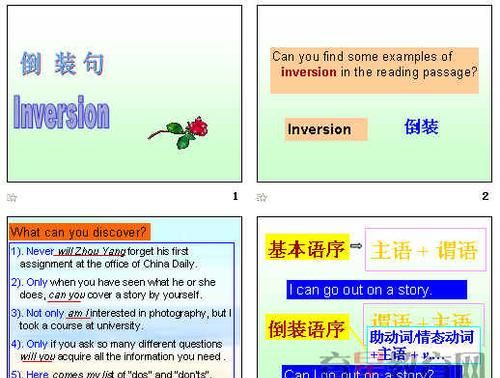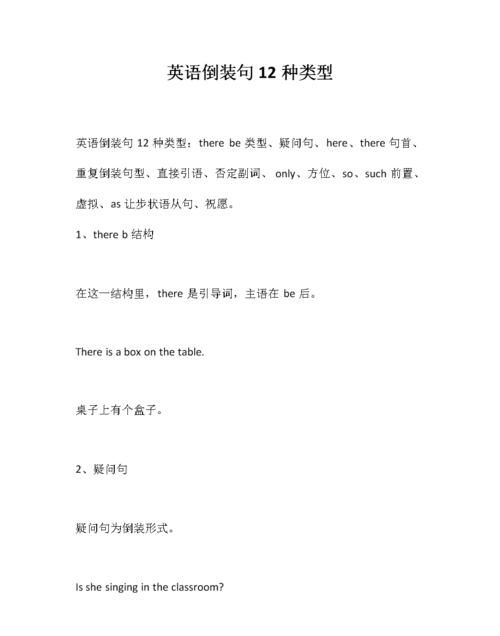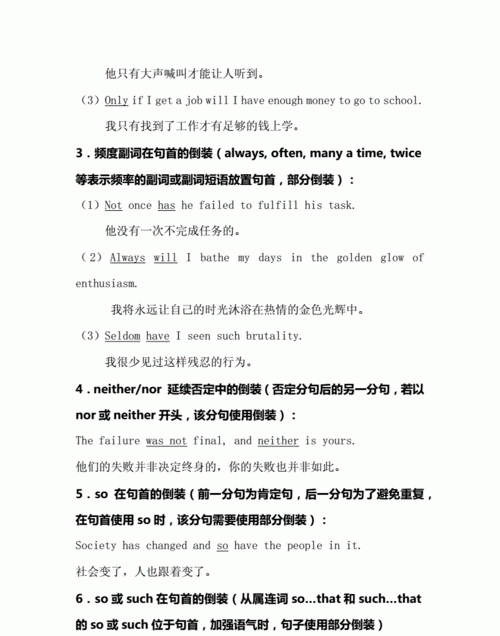本文目录
高中英语倒装句思维导图
①倒装句常规结构
基本句型1:主语第1位,谓语第2位;
基本句型2:主语第1位,系动词第2位,表语第3位;
基本句型3:主语第1位,谓语第2位,宾语第3位;
基本句型4:主语第1位,谓语第2位,间接宾语第3位,直接宾语第4位;
基本句型5:主语第1位,谓语第2位,宾语第3位,宾语补语第4位;
②非常规结构
如果在句子中,上述这5种角色的位置不按常规结构布局,则会产生非常规结构。具体表现为:
主语位置的变化;
谓语位置的变化(包括表语);
宾语位置的变化;
宾语补语位置的变化。

倒装句之全部倒装
1 here, there, now, then, thus等副词置于句首, 谓语动词常用be, come, go, lie, run。
There goes the bell.
Then came the chairman.
Here is yourletter.
2 表示运动方向的副词或地点状语置于句首,谓语表示运动的动词。
Out rushed a missilefrom under the bomber.
Ahead sat an old woman.
3 表+be+主
注意:上述全部倒装的句型结构的主语必须是名词,如果主语是人称代词则不能完全倒装。例如:Here he comes. Away theywent.
倒装句之部分倒装
4 句首为否定或半否定的词语,如no, not, never, seldom, little,hardly, at no time, in no way, not until… 等。
Never have I seen such aperformance.
Nowhere will you find the answer to this question.
Notuntil the child fell asleep did the mother leave the room.
当Notuntil引出主从复合句,主句倒装,从句不倒装。
注意: 如否定词不在句首不倒装。
I have never seensuch a performance.
The mother didn’t leave the room until the child fellasleep.
5 以否定词开头作部分倒装
如 Not only…but also, Hardly/Scarcely…when, Nosooner… than
Not only did he refuse the gift, he also severely criticizedthe sender.
Hardly had she gone out when a student came to visit her.
No sooner had she gone out than a student came to visit her.
6 so, neither,nor作部分倒装
表示也、也不 的句子要部分倒装。
Tom can speak French. So can Jack.
If you won’t go, neither will I
7 、only在句首要倒装的情况
Only in this way, can you learn English well.
Only after being asked three times did he come to the meeting.
如果句子为主从复合句,则主句倒装,从句不倒装
Only when he is seriously ill, does he ever stay inbed.
8 as, though 引导的倒装句
as / though引导的让步从句必须将表语或状语提前 (形容词, 副词,分词, 实义动词提前)。
注意:
1) 句首名词不能带任何冠词。
2) 句首是实义动词,其他助动词放在主语后。如果实义动词有宾语和状语, 随实义动词一起放在主语之前。
Try hard as he will, he neverseems able to do the work satisfactorily.
注意:
让步状语从句中,有though,although时,后面的主句不能有but,但是 though 和yet可连用。
9 其他部分倒装
so… that 句型中的so 位于句首时,需倒装。
So frightened was he that hedid not dare to move an inch.

英文倒装句
给你找了一段比较详尽的解释 有例句和例题什么的 看了之后你就全懂了
倒装是一种语法手段,用于表示一定的句子结构或强调某一句子成分。
倒装句有两种:完全倒装和部分倒装。
1.完全倒装
1) 完全倒装即把整个谓语放到主语之前(是整个谓语动词,而非助动词)。
例如:In came the teacher and the class began. (老师走了进来,然后开始上课。)
2) there引出的完全倒装句:除了最常见的there be句型以外,there还可以接appear, exist, lie, remain, seem to be, stand等,一般都译成"有"的含义,构成完全倒装句。
例如:There appeared to be a man in black in the distance.(远处有个穿黑色衣服的人。)
3) 由地点和时间副词引出的完全倒装句:以地点副词here, there和时间副词now, then 开头,后面的动词是be, come, exist, fall, follow, go, lie, remain, seem, stand等,而主语又是名词时,构成完全倒装句。
例:Under that tree sits a beautiful girl.(那棵树下坐着一位美丽的姑娘。)
例:_________ from the tenth floor when the policeman pointed his pistol at him.
A) Jumped down the burglar B) Down the burglar jumped
C) The burglar jumps down D) Down jumped the burglar
答案是D) Down jumped the burglar。因为地点状语Down位于句首应该用完全倒装,整个谓语动词应位于主语之前。C) The burglar jumps down虽然是自然语序,但时态错误,应该用和时间状语从句一致的过去时,而不是现在时。
注意:
1) 在here, there引出的倒装句中,当主语是普通名词时用完全倒装句,但当主语是代词时,就要用部分倒装句。
例:Here comes the postman!(邮递员终于来了!注意实意谓语动词位于主语之前。)
Here we are.(我们到了。注意系动词位于主语代词之后。)
2) 注意正语序和倒装语序的语气、意义是区别:
例:Here is the picture I love.(这正是我所喜爱的画。)
The picture I love is here.(我所喜爱的话在这里。)
3) 当主语是代词,谓语是系动词,表语是说明性的词、词组和定语从句时,可以使用完全倒装句,起强调作用。
例:Lucky is he who has been enrolled into a famous university.(他真幸运,被一所名牌大学录取了。)
2. 部分倒装
1) 部分倒装即只把谓语的一部分(如助动词、情态动词等)放到主语前,或把句子的强调成分提前。
例:1996年6月四级第42题
_______ right now, she would get there on Sunday.
A) Would she leave B) if she leave
C) were she to leave D) If she had left
结合选项,全句的意思是:“如果她立刻就走,她就能在星期天到达那里”。答案是C。
2) 以否定词开头的句子要求部分倒装。注意下列句子中助动词或情态动词提前、甚至补充助动词的用法:
例:Not until yesterday did little John change his mind.(小约翰直到昨天才改变了主意。)
例:1999年6月四级第66题
In no country ______ Britain, it had been said, can one experience four seasons in the course of a single day.
A) better than B) more than C) other than D) rather than
本题是个倒装句,答案是C) other than。no other than意思是“正是、就是”;而rather than的意思是“宁愿……而不……;而不是”。
3) 以否定副词开头并加状语的句子要求部分倒装。这些否定副词有barely, hardly, little, seldom, scarcely…… when, never, no sooner…… than, rarely, no more, nor nearly, not only等以及only。
例:1997年6月四级第43题
Only under special circumstances _________ to take make-up tests.
A) are freshmen permitted C) permitted are freshmen
B) freshmen are permitted D) are permitted freshmen
全句的意思是:“一年级学生只有在特殊的情况下才可以允许补考。”本陈述句以only开始,后面接状语,应当用部分倒装句。所以答案是A) are freshmen permitted。如用自然语序,本题所在的句子就应该改写为:Freshmen are permitted to take make-up tests only under special circumstances.这两句话的差别是,前者将only under special circumstances放到句首,表示对状语的强调。注意:在部分倒装句中,只有助动词、情态动词或连系动词to be可以置于主语之前,其它部分都要置于主语之后。
注意:
a) 如果含有从句时,只要求主句倒装:
例:Only after he had spoken out the word did he realize he had made a big mistake.(只有当他已经说出那个字后才意识到自己犯了个大错误。)
b) 如果上述否定副词出现在强调句型中的前半部分,不用倒装:
例: It was not until he went abroad that he know the truth of the fact.(直到他出国以后才了解到事实真相。)
c) 如果hardly, scarcely后面接的是any, ever, at all时,意义类似almost no/ not/ never(几乎不、从不),则无须倒装。
例:Hardly any people having been invited went there.(几乎没有什么受到邀请的人去那里了。)
4) 由no matter how, however和how引导的状语从句要求部分倒装,因为形容词或副词通常紧跟在这三个引导词后面,然后才是主语和谓语,形成形式上的部分倒装句:
例:I know nothing about this river, neither how long, how wide nor how deep it is.(我一点也不了解这条河,不知道它有多长,多宽或多深。)
5) 由as引导的部分倒装句:
a) 当as作为比较意义时,即用于as + adj./ adv. + as结构中时,如果把第一个as省略掉,就形成部分倒装句。
例:Cautious as the rest of her family (was) , she didn';t seem willing to give an immediate reply to my question.(正如她家里人一样谨慎小心,她似乎不愿意立即回答我的问题。)
She ran down the stairs, quick as a rabbit (ran).(她跑下楼去,跑得象兔子那么快!)
b) 当as引导让步状语时,和although, though一样,当用作“尽管”之义时,可以用于部分倒装句。
例:_______, there was no hope of her being able to sleep.
A) As she was exhausted B) If she was exhausted
C) Exhausted though she was D) Now that she was exhausted
答案是C) Exhausted though she was。从属连词as, though可以用于让步状语从句中。这种从句必须以形容词(或形容词化的分词)、名词或动词原形开头,主语必须位于从句之后。D) Now that she was exhausted里的引导词Now that表示“既然”;B) If she was exhausted表示条件“如果”; A) As she was exhausted表示“由于”(因为使用的是正语序),都与后面句子的意思不通顺。
c) 表示原因时,为了强调起见,也可以倒装。
例:Tired as he was, we decided not to disturb him.(因为他太累了,我们决定不打扰他。)
d) 等于so时,意义是“也,也是”
例:She worked hard, so/ as did her husband. (她工作很努力,她的丈夫工作也很努力。)
3. 其它情况的倒装句
1) so, neither, nor除了构成上述倒装句以外,还可以取代上文出现的名词、形容词甚至整句话,构成完全倒装句或部分倒装句。但这两种倒装的意义不同。
a) 当so表示“也,相同,那样”时,通常表示对前一句肯定句的赞同、一致内容,要求使用完全倒装句:
例:I asked him to complete the experiment before five, so he did (=and he did that).(我让他在5点以前完成实验,他做到了。)
b) so /such ……that句型可以构成部分倒装句,表示强调so /such和that之间的部分:
例:So unreasonable was his price that everybody startled.(他的要价如此之高,令每个人都瞠目结舌。)
To such length did she go in rehearsal that the two actors walked out.(她的彩排进行得那么长,以致于两个演员都走出去了。)
c) neither和nor共有4种倒装形式,其含义分别为:
完全倒装时:表示"也不",和上文a)用法正好相反,表示对前一句否定句的赞同或一致内容。
例:You don';t know what to do now, neither/ nor do I .(你不知道现在该做什么,我也不知道。)
和其它否定副词连用,表示"也(不)",也要求用完全倒装句:
例:The besieged enemy could not advance, nor / neither could they retreat.(被包围的敌人既不能进,也不能退。)
注意:若把这句话改成:"The besieged enemy could neither advance nor retreat.(被包围的敌人既不能进,也不能退。)"就不必倒装。
例:1990年1月四级第59题
She never laughed, ______ lose her temper.
A) or she ever did B) nor did she ever
C) or did she ever D) nor she ever did
本题的句子是一个并列句,全句意思是:“她从来不大声笑,也没有发过脾气”。当前面的分句含否定意义而且后面的分句也含否定的意思时,后面的反句通常用含否定意义的nor(或neither)连接。此外,nor(或neither)连接的分句应当用倒装句,及其谓语中的情态动词、连系动词或助动词应放主语之前。所以B) nor did she ever是答案。本句相当于:"…, and she never lost her temper, either"。
1) 用在肯定句里,构成一般否定倒装:
例:All that is true, nor must we forget it.(那全都是真的,我们可不能忘记。)
2) 部分倒装,有承上启下作用,表示同意和赞同:
例:A: I couldn';t do anything for her.(我帮不了她。)
B: Nor you could, but you might have got somebody to help her.(你是不能帮她,但你本可以找人帮她的。)
3) 在进行比较的句子里,如果主语不是代词时,可以倒装:
例:America consumes more energy than did our country.(美国消耗的能源比我们国家多。)
Her face is rather pale and even paler are her hands.(她的脸色苍白,她的手更白。)

英语倒装句型举例 举例说明英语的各种倒装句型多多益善不过一种形式的一两个句子就行了
倒装 分 完全倒装 和 部分倒装
完全倒装就是【谓语】位于【主语】之前,一般顺序是 【副词+谓语+主语】(当主语是【代词】的时候,无需倒装)
例子如下:
1.Down fell the man.{副词down,谓语动词fell,主语the man}
Down he fell.{副词down,主语是代词he,谓语动词fell,当主语是【代词】的时候,无需倒装}
诸如in /out /up /down /off /away /over /back这些【副词】放在句首,句子就要倒装啦
2.还有there /here /now /then /thus放在句首的时候,要全部倒装.
Here are the books.
There goes the bell.
Now comes your turn.
There be句型是典型的完全倒装.
3.时间地点状语放句首的时候,句子全部倒装.
部分倒装 是【情态动词/助动词/be动词】+【主语】+【谓语】的顺序.
1.only+状语 放在句首,部分倒装
Only then did I realize the importance.【only+状语then,did I realize 部分倒装,助动词did+主语I+谓语动词realize】
Only in this way can you fool him.【only+状语in this way,can you fool 部分倒装,情态动词can+主语you+谓语动词fool】
Only when the class is over,can I see her.【only+when引导的状语从句放句首,从句不倒装,主句要到装】
2.not until放句首
Not until midnight did it stop raining.
3.not only...but also...前倒后不倒
Not only did he learn from books but also (he learned from) practice.[因为累赘,可将括号内容省略]
4.Neither...nor...前后均倒装

以上就是关于倒装句都有什么句式英语 ,高中英语倒装句思维导图的全部内容,以及倒装句都有什么句式英语 的相关内容,希望能够帮到您。

